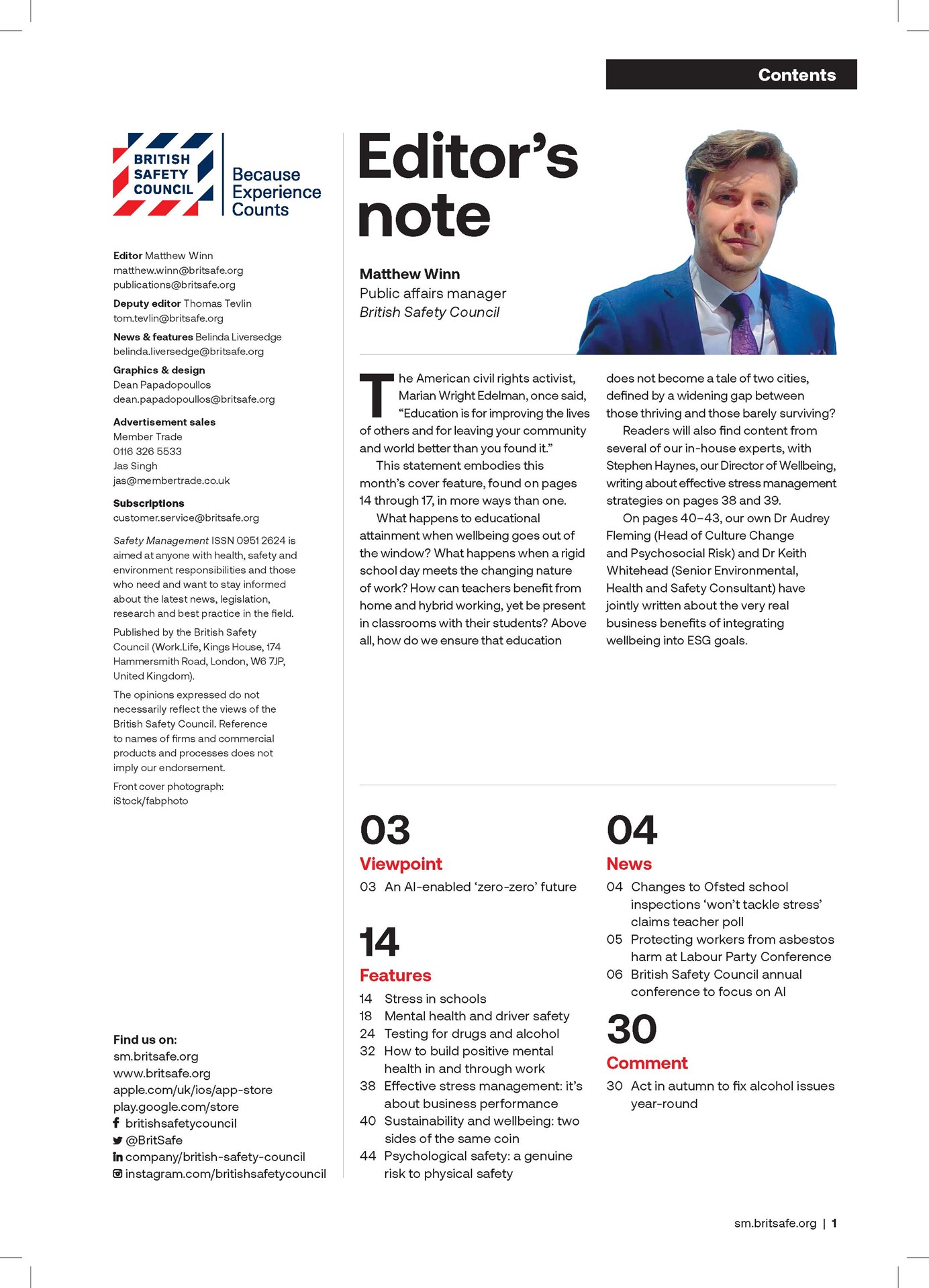Research shows that investing in employee wellbeing brings financial benefits for a business, but it’s essential employers carefully plan and implement their wellbeing programme, rather than taking an ad-hoc or reactive approach to problems.
Features
Wellbeing at work: a strategic approach is key
For those who are altruistic by nature the thought of needing to create a business case for workplace wellbeing might be quite unusual. In some cases, it isn’t needed because the decision-makers recognise it as being the right thing to do. However more often than not, when it comes to workplace wellbeing, the question is often ‘why should we invest?’. Before we can answer than question, we need to understand what wellbeing is.
 Wellbeing is impacted by factors such as line management, inclusion, career development and financial support. Photograph: iStock
Wellbeing is impacted by factors such as line management, inclusion, career development and financial support. Photograph: iStock
According to the British Safety Council, wellbeing is ‘an individual’s ongoing state which enables a person to thrive’. So an employer, director or manager may be wondering where can I you start when it comes to creating a business case for wellbeing in the workplace? According to the Chartered Institute of Personnel and Development (CIPD) there are seven domains to workplace wellbeing, as shown in the diagram on the next page.
The diagram shows that wellbeing is impacted by not just someone’s physical safety or health, but also by factors such as line management, inclusion, career development and financial support.
So, when looking to develop a business case for wellbeing, any one of these domains could be considered.
Traditionally speaking, the business case for wellbeing will often be needed in order to convince the purse-string holders that investment or change is needed. So why should organisations (of all sizes) be investing in the wellbeing of their workforce and how can they maximise the success of their wellbeing initiatives and programmes?
The problem
In order to draw up the business case for wellbeing, an employer needs to start with what the problem is and where the investment is needed. With inflation reaching record highs, the cost of living following suit and the uncertainty surrounding the UK economy, businesses will be reviewing their costs to determine where they might be able to save.
So why should a business review – and, if necessary, expand and enhance – the wellbeing support they have in place for their workforce at times like this?
The case for investment is made clear by new data from the Health and Safety Executive (HSE) on the scale of work-related ill health and the associated cost to UK businesses in 2021/22. This shows that:
- 1.8 million working people are suffering from a work-related illness
- 914,000 workers are suffering work- related stress, depression or anxiety
- 477,000 workers are suffering from a work-related musculoskeletal disorder (MSD)
- 36.8 million working days were lost due to work-related illness and workplace injury
- £18.8 billion is the estimated annual cost of injuries and ill health from current working conditions.
 Marcus Herbert: "More often than not, when it comes to workplace wellbeing, the question is often ‘why should we invest?’"
Marcus Herbert: "More often than not, when it comes to workplace wellbeing, the question is often ‘why should we invest?’"
The vast majority of work-related illness is because of either work-related stress, depression, anxiety or because of a work-related MSD. Given the significant cost to UK businesses of these conditions, businesses should be looking at ways to reduce the prevalence of work-related ill health. Not only would this help to reduce the amount of employee absence, it would also have a positive impact on the productivity of the workforce.
In fact, according to one study published by the Social Market Foundation happy employees are up to 20 per cent more productive than unhappy employees. This is just one example of the positive outcomes from correctly investing in wellbeing.
The solution
So once an employer is aware of the cost of work-related illness, they need to consider what measures they should be implementing to address and tackle the causes.
The traditional approach to workplace wellbeing is to offer a series of tertiary benefits that can be used ‘when problems arise’. In the case of work-related stress, it might be access to counselling. For musculoskeletal issues it could be physiotherapy provision. And while both interventions will often address the issue and may even prevent further problems occurring, when it comes to wellbeing, businesses should be assessing what may have contributed to these work-related issues occurring in the first place.
For example, if the cause of someone’s work-related stress was their relationship with their line manager, providing counselling for the affected employee won’t improve the relationship. Likewise, providing massage, physiotherapy and exercise guidance to address a repetitive strain injury that is caused by a typical movement for a factory worker will not prevent the strain re-occurring.
Organisations therefore need to look beyond matching wellbeing benefits to work-related illnesses and focus more on the actual needs of the organisation. One of the most impactful ways to truly understand the needs of an organisation is to take a strategic approach to wellbeing.
To take a strategic approach to wellbeing, organisations need to first learn the optimum steps for a successful and sustainable health and wellbeing programme. Following this, they should assess their requirements and current activities – and evaluate gaps in their provision and current strategy.
Once a strategy and supporting plan have been developed, there needs to be involvement from leadership and a clear communication and engagement plan that is relevant to the organisation. In time there should be measurable outcomes that allow assessment of what has worked and what hasn’t so the employer can refine and focus their efforts to ensure their wellbeing policies and initiatives are having the required effect – and addressing the actual problems.
The results
There is evidence that supports the business case for taking a strategic approach to wellbeing, that a HR director, a health and safety director/manager, any other leaders within a business can use to create a business case to convince other decision-makers of the benefits of investing in employee wellbeing.
For instance, research from Deloitte in April 2022 showed that on average the return on investment in employee mental health was £5.30 for every £1 spent. Naturally, the size of the return will vary depending on the nature of the intervention and of course the outcomes will be enhanced if the intervention is based on the needs of employees.
 Once a strategy and supporting plan have been developed, there needs to be involvement from leadership and a clear communication plan. Photograph: iStock
Once a strategy and supporting plan have been developed, there needs to be involvement from leadership and a clear communication plan. Photograph: iStock
Furthermore, research from CIPD and Simplyhealth in April 2022 found that organisations that take a strategic approach to wellbeing – rather than ad hoc interventions – saw better outcomes across 10 areas. These included lower sickness absence, reduced work-related stress and improved productivity (see Health and wellbeing at work survey 2022, figure 12, page 17 – ‘What has your organisation’s employee health and wellbeing activity achieved?’).
Conclusion
By developing a wellbeing strategy with a clear mission, baseline data, communication plan and measurable outcomes, businesses will be able to achieve success in a multitude of areas – not least in reducing work-related illness and increasing productivity.
Marcus Herbert is head of wellbeing at the British Safety Council
For information on the Being Well Together programme see:
beingwelltogether.org
FEATURES

Why menstruation support matters at work
By Deborah Garlick, Menstruation Friendly by Henpicked on 03 December 2025
Although forward-thinking organisations are increasingly taking action on menopause awareness and support at work, attention is now turning to menstrual health as the next essential step in building an inclusive, equitable and high-performing workplace.

Neurodiversity at work: getting started on creating a supportive environment for neurodivergent workers
By Andy Hooke CMIOSH Chartered health and safety consultant on 03 December 2025
Creating a neuroinclusive workplace brings many benefits, including making neurodivergent employees more comfortable about seeking help and support from managers and colleagues, and there are some simple ways of getting started with the process.

Human-centred technology for better work design: rethinking musculoskeletal disorder prevention
By Cam Stevens, Pocketknife Group on 03 December 2025
Although technologies like computer vision analysis, machine learning and wearable sensors are increasingly being used to identify and assess the causes of work-related musculoskeletal disorders (MSDs), it’s essential to consider data relating to all aspects of work design when seeking to reduce MSDs in the workplace.



